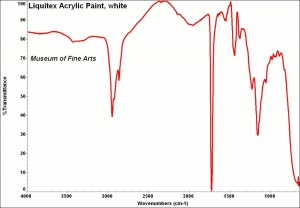Difference between revisions of "Liquitex acrylic paints"
m (Text replace - "== Authority ==" to "== Sources Checked for Data in Record ==") |
|||
| Line 3: | Line 3: | ||
[Permanent Pigments] A brand name for an acrylic water-emulsion paint first marketed in 1954. Liquitex acrylic paints initially used Rhoplex AC-33 as a base medium. Liquitex paints dry quickly to for a tough film with brilliant colors. Liquitex paints were initially thin and runny, but their formulation was changed in 1963 with a thicker consistency for distribution in tubes (Learner 2000). Liquitex paints have been used by Helen Frankenthaler, David Hockney, Robert Motherwell, and Andy Warhol (Learner 2005). | [Permanent Pigments] A brand name for an acrylic water-emulsion paint first marketed in 1954. Liquitex acrylic paints initially used Rhoplex AC-33 as a base medium. Liquitex paints dry quickly to for a tough film with brilliant colors. Liquitex paints were initially thin and runny, but their formulation was changed in 1963 with a thicker consistency for distribution in tubes (Learner 2000). Liquitex paints have been used by Helen Frankenthaler, David Hockney, Robert Motherwell, and Andy Warhol (Learner 2005). | ||
| + | == Applications == | ||
[[[SliderGallery rightalign|LiquitexwhiteIR.jpg~FTIR]]] | [[[SliderGallery rightalign|LiquitexwhiteIR.jpg~FTIR]]] | ||
| − | == | + | == Risks == |
| + | |||
| + | == Physical and Chemical Properties == | ||
Dry films soluble in acetone. | Dry films soluble in acetone. | ||
| Line 18: | Line 21: | ||
* Ralph Mayer, ''A Dictionary of Art Terms and Techniques'', Harper and Row Publishers, New York, 1969 (also 1945 printing) | * Ralph Mayer, ''A Dictionary of Art Terms and Techniques'', Harper and Row Publishers, New York, 1969 (also 1945 printing) | ||
| − | |||
| − | |||
| − | |||
| − | |||
* R. G. Lodge, A History of Synthetic Painting Media with Special Reference to Commercial Products, AIC Preprints, 16th Annual meeting, 1988 | * R. G. Lodge, A History of Synthetic Painting Media with Special Reference to Commercial Products, AIC Preprints, 16th Annual meeting, 1988 | ||
Revision as of 19:04, 19 May 2020
Description
[Permanent Pigments] A brand name for an acrylic water-emulsion paint first marketed in 1954. Liquitex acrylic paints initially used Rhoplex AC-33 as a base medium. Liquitex paints dry quickly to for a tough film with brilliant colors. Liquitex paints were initially thin and runny, but their formulation was changed in 1963 with a thicker consistency for distribution in tubes (Learner 2000). Liquitex paints have been used by Helen Frankenthaler, David Hockney, Robert Motherwell, and Andy Warhol (Learner 2005).
Applications
Risks
Physical and Chemical Properties
Dry films soluble in acetone.
Additional Information
° Thomas J.S. Learner, Analysis of Modern Paints, Getty Conservation Institute, Los Angeles, 2004.
° T. Learner, "A Review of Synthetic Binding Media in Twentieth-Century Paints" The Conservator, No. 24, pp. 96-103, 2000.
Sources Checked for Data in Record
- Ralph Mayer, A Dictionary of Art Terms and Techniques, Harper and Row Publishers, New York, 1969 (also 1945 printing)
- R. G. Lodge, A History of Synthetic Painting Media with Special Reference to Commercial Products, AIC Preprints, 16th Annual meeting, 1988
- Marie Svoboda, Conservation Survey Index, unpublished, 1997
- Gordon Hanlon, contributed information, 1998
